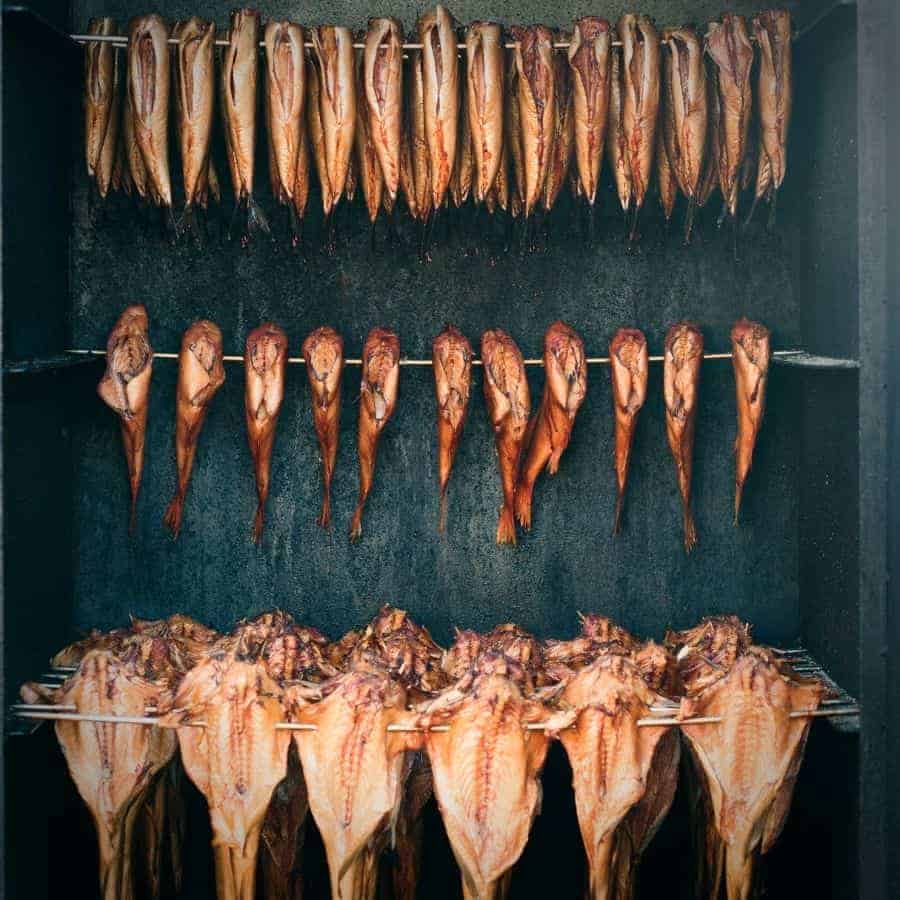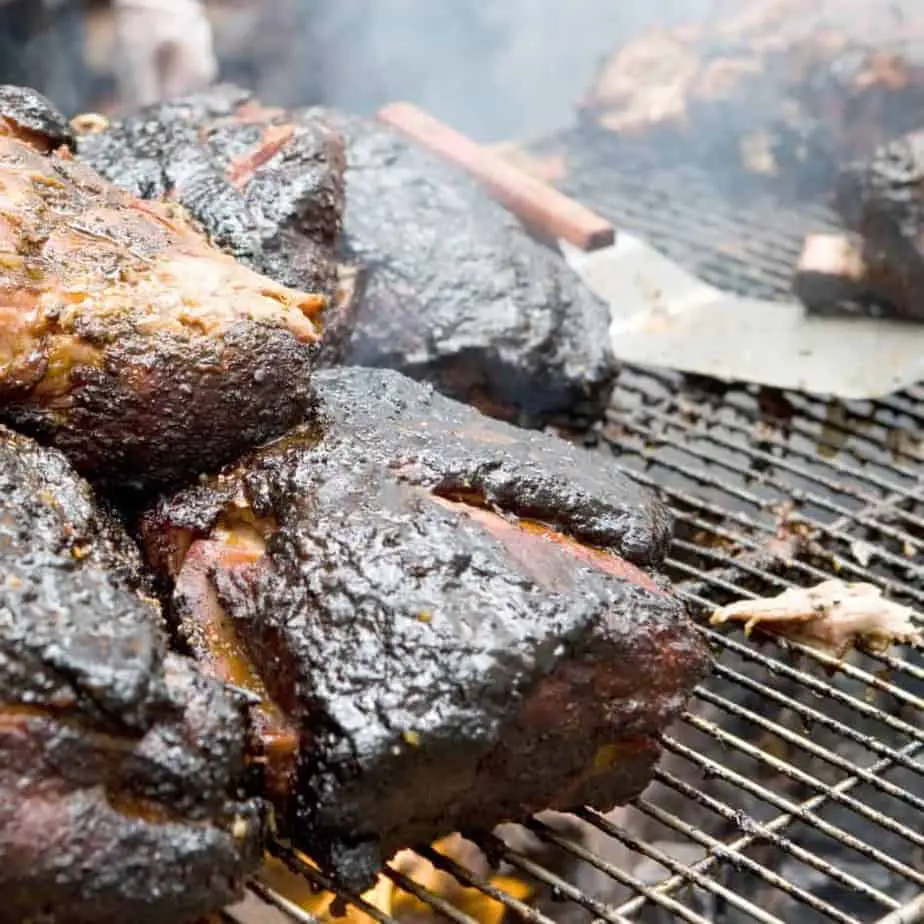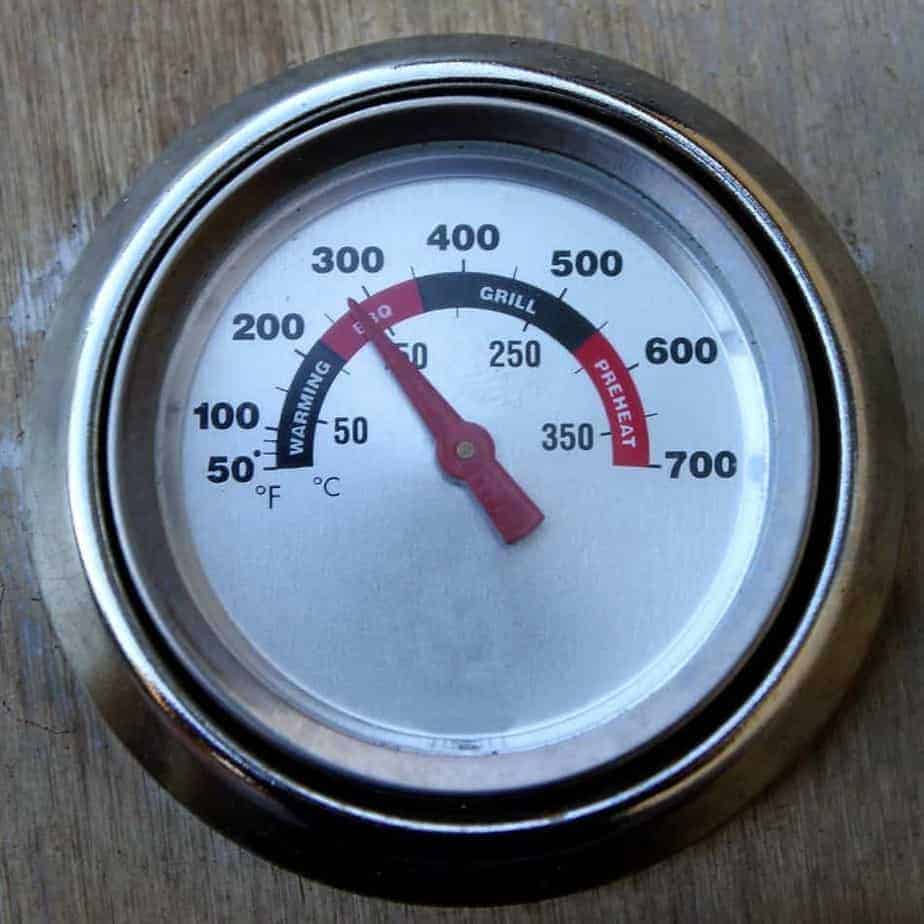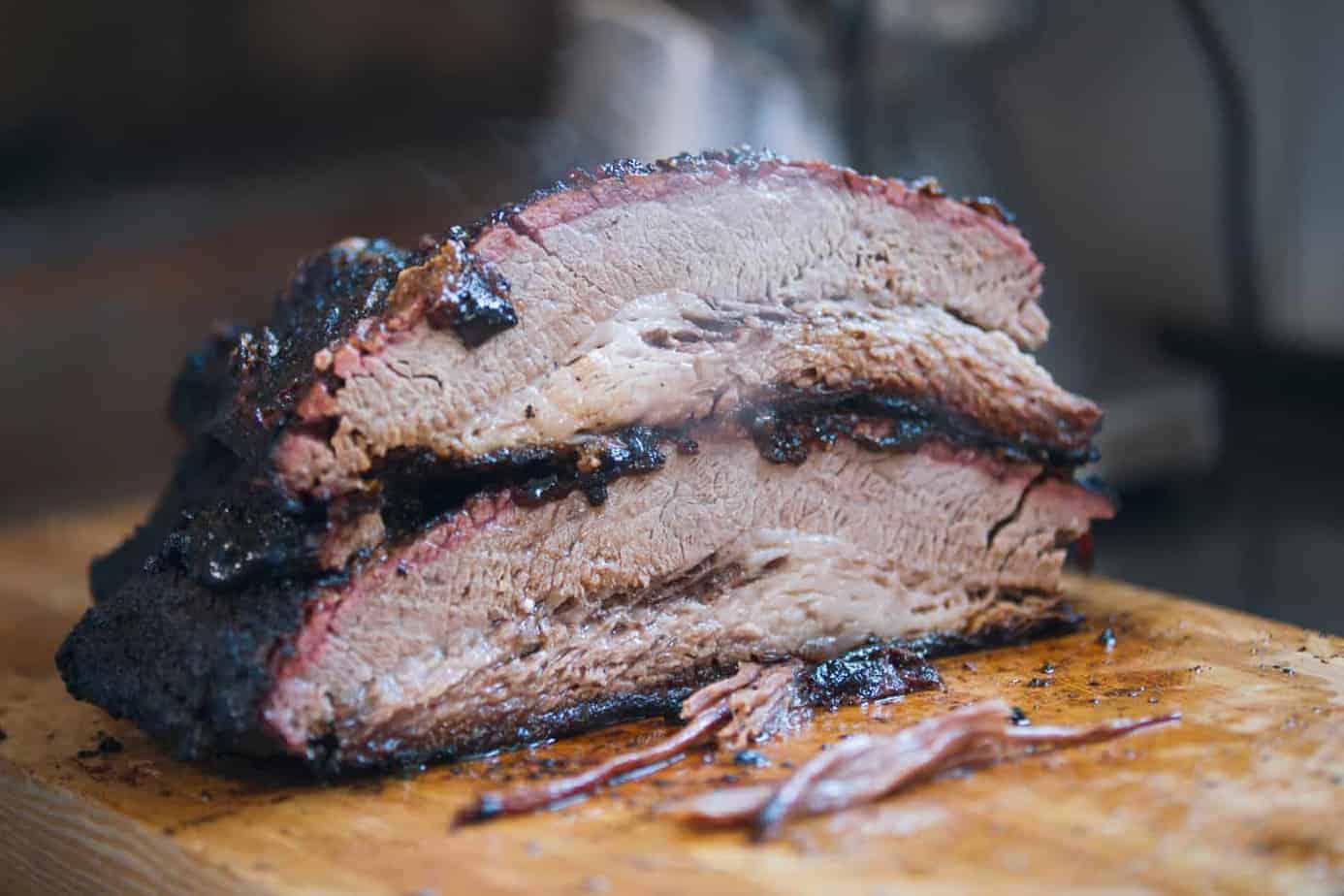The Definitive Guide To BBQ Cooking Times and Temperatures
Disclosure: This post may contain affiliate links. If you use these links to buy something we may earn a commission at not additional cost to you. Learn more.
BBQ smoking is one of the more sophisticated methods of cooking meat and vegetables on the BBQ pit and requires a lot of know-how (and patience) in order to complete successfully. One of the most challenging aspects of smoking food is knowing when the food is thoroughly cooked and ready to eat.
How do you know when your BBQ smoked food is ready? There are things you can look for in your smoked food that will signal it is ready to eat, such as clear running juices and a caramelized outer crust. Internal temperature is another indicator that should be checked.
Different meats and vegetables require different cooking times and temperatures, and if you are familiar with them, you will have an easier time determining whether your food is finished cooking.

What is BBQ Smoking?
Unlike what most may know as grilling or barbecuing, smoking is the process of cooking food by exposing it to the smoke generated inside your BBQ pit or smoker for various–often longer–periods of time. The result is food with a smoky taste and a unique mesquite flavor.
BBQ Smoking Times and Temperatures
Knowing at what temperature and length of time you need to smoke your food is essential to ensure your food has enough time to cook completely and achieve that desired smoky flavor you are after. All you need is a meat thermometer and a timer!
The following are guidelines for smoking temperatures, times, and finished cooking internal temperatures for a variety of foods.
IMPORTANT: The times below are approximate times and can give you a rough idea. The most important thing to understand about BBQ is that doneness is measured by meat temperature, as well as the texture you are aiming for…not a specific time. It’s done when it’s done, not when the clock says so.
Chicken
Chicken is one of the easiest meats to smoke due to their shorter cooking times. However, depending on whether or not you plan on smoking the whole chicken or only a quarter or other part, the time it takes to smoke may differ, while the temperature will remain the same.
| Chicken Section | Ideal Smoking Temperature | Smoking Time | Finished Internal Temperature |
| Chicken Legs | 275°-350° F | 1.5 hours | 170° F |
| Chicken Wings | 275°-350° F | 1.25 hours | 170° F |
| Chicken Breasts | 275°-350° F | 2 hours | 165° F |
| Chicken Thighs | 275°-350° F | 1.5 hours | 170° F |
| Chicken Quarters | 275°-350° F | 1 – 2 hours | 170° F |
| Whole Chicken | 275°-350° F | 2 – 3 hours | 170° F |
If you are looking for a high quality thermometer to track your temps, I would highly recommend one from ThermoWorks. I’ve tried cheap knock-offs from random Amazon sellers, but nothing compares to the real thing.
Tips for Smoking Chicken
- Pat the chicken dry before adding to the grill for smoking; this will ensure that the meat absorbs the smoke better and will result in a light, crispy taste when finished.
- A smoked chicken will continue to cook for a short period even after you remove it from the grill. To avoid overcooking or drying out, take it out when it reaches an internal temperature of 160° F – 165° F. After a few minutes, it should naturally reach the perfect temperature of 165° F – 170° F outside of the grill.
- In general, a smoking chicken will take 30-45 minutes/pound as long as you cook at 250 degrees Fahrenheit.
- Chicken Breasts
- Chicken breasts can be quite difficult to smoke evenly due to their shape and size. For a more even cook, use a meat tenderizer to flatten all sides, so the entire chicken breast pieces have an even thickness.
- Whole Chicken
- To ensure the chicken cooks evenly and thoroughly, consider butterflying the chicken. This requires that you cut the meat along the spine, removing both it and the breastbone. From here, you will be able to lay the chicken flat on the grill without a problem.

Beef
Beef can be smoked around the same temperature range, but require different amounts of time to cook. Unlike chicken, different sections or types of this meat need to achieve various internal temperatures in order to be considered done.
|
Beef Section |
Ideal Smoking Temperature |
Smoking Time |
Finished Internal Temperature |
| Beef Ribs (Short Ribs) | 225-250° F | 6 – 8 hours | 190-200°F |
| Beef Back Ribs | 225-250° F | 3 – 4 hours | 185-190°F |
| Beef Brisket (Pulled) | 225-250° F | 70 – 90 minutes/pound | 198-203° F |
| Beef Brisket (Sliced) | 225-250° F | 70 – 90 minutes/pound | 190-195° F |
| Beef Tenderloin | 225-250° F | 2.5-3 hours | 130°-140° F |
| Chuck Roast (3-4lbs) | 225-250° F | 12 – 20 hours | 190-200°F |
| Prime rib | 225-250° F | 15 minutes/lb | 135° F for Medium |
| Tri-tip | 225-250° F | 2 – 3 hours | 130° F to 140° F |
Tips for Smoking Beef
- Back Ribs
- With back ribs, to ensure an even smoking, cut the ribs apart before cooking.
- The max time to cook a full set of back ribs is 4-6 hours.
- Briskets
- Briskets can differ in thickness and therefore require different temperatures to cook thoroughly. The thicker the flat sections are, the higher the temperature should be.
- Cooking a full brisket can take between 12-20 hours to cook, approximately 70-90 minutes/pound.
- To test if briskets are done, insert a skewer into the meat. If there is no resistance, the brisket is finished cooking. (It should feel like peanut butter when probing it)
- Short Ribs
- The tenderness level of short ribs can indicate how done they are.
- Chuck Roast
- Cooking times for chuck roasts will depend on the thickness of the roast.

Pork
Pork chops and baby back ribs are one of the more common pork meats to smoke, although many other pork options turn out just as delicious!
|
Pork Section |
Ideal Smoking Temperature |
Smoking Time |
Finished Internal Temperature |
| Pork Baby Back Ribs | 225-250° F | 5 hours | 180°F |
| Spare Ribs | 225-250° F | 5 – 7 hours | 180 – 185°F |
| Bacon (Pork Belly) | 225-250° F | 6 – 8 hours | 195 – 200° F |
| Pork Sausage | 225-250° F | 1 – 3 hours | 165° F |
| Pork Tenderloin | 225-250° F | 2.5 – 3 hours | 160° F |
| Pork Butt / Shoulder | 225-250° F | 1.5 hours/lb | 200 – 205° F |
| Ham Hocks | 200 – 225° F | 2 hours | 150° F |
| Pork Chops | 225-250° F | 1.5 hours | 145° F |
| Whole Pork | 225-250° F | 16 – 18 hours | 205° F |
Tips for Smoking Pork
- Baby Back Ribs
- Baby back ribs that have more meat will often need an extra hour of cooking time to finish cooking and become tender.
- If the meat is tender, it is most likely finished cooking.
- Look for the meat pulling away from the bones and the meat wanting to crack or split when picking it up with tongs.
- Spare Ribs
- Similarly to baby back ribs, if the spare rib meat is tender, it is done cooking.
- Look for the meat pulling away from the bones and the meat wanting to crack or split when picking it up with tongs.
- Similarly to baby back ribs, if the spare rib meat is tender, it is done cooking.
- Pork Tenderloin
- With pork tenderloin, although the general recommended internal temperature at which it is finished cooking is 160 degrees Fahrenheit, some chefs recommend having the meat reach a lower temperature of 140° F instead.
- Pork Shoulder/Pork Butt
- Pork shoulder, or pork butt, usually has a large amount of fat that makes it difficult for the meat to cook all the way through, so be sure to trim any excess fat you find.
- Once the meat has reached an internal temperature of about 160-165° F, remove it from the grill and wrap it in aluminum foil. After this, return the meat to the grill and cook until it reaches an internal temperature of 195-205° F.
- Pork Sausage
- Preheat your BBQ pit, grill, or smoker for at least one hour before adding sausages.
- Once you have added the sausages to the grill, add more wood or charcoal to increase the temperature and produce more smoke.
- Add toothpick-sized holes to the sausage to allow extra heat to escape and maintain its shape while cooking.
Lamb
Although this meat is not a standard smoking option, lamb can just as easily absorb smoke and end up having a tasty, unique flavor.
|
Lamb Section |
Ideal Smoking Temperature |
Smoking Time |
Finished Internal Temperature |
| Lamb Leg | 225-250° F | 4 – 8 hours | 140° – 150° F |
| Lamb Shoulder | 225-250° F | 5 – 5.5 hours | 170° F |
| Lamb Shank | 225-250° F | 4 – 5 hours | 190° F |
Tips for Smoking Lamb
- Apple, oak, and hickory woods are ideal wood types for smoking lamb, and best compliments its natural flavor.
- Lamb Leg
- Marinade the lamb leg for at least 5-10 hours before smoking for the best results.
- Lamb Shoulder
- If it is your first time smoking lamb, it may be best to look for deboned lamb shoulder to make the cutting and smoking process more manageable.
- Before cooking, trim away any excess fat to ensure the meat cooks evenly.
Turkey
A common delicacy around Thanksgiving, smoked turkey adds a whole new taste to the traditional main course.
|
Turkey Section |
Ideal Smoking Temperature |
Smoking Time |
Finished Internal Temperature |
| Turkey Legs | 275°-350° F | 2 – 3 hours | 170° F |
| Turkey Wings | 275°-350° F | 2 – 2.5 hours | 170° F |
| Turkey Breasts | 275°-350° F | 4 hours | 165° F |
| Whole Turkey (<12lbs) | 275°-350° F | 4 – 5 hours | 165° F in Breast & 185° F in thigh |

Tips for Smoking Turkey
- Whole Turkey
- Similarly to an entire chicken, butterfly the turkey so that it can lay flat and absorb the most smoke for an even, thorough cooking.
- To allow the most flavor to come through, rub the outside of the turkey with your choice of oil before applying a dry rub. Alternatively, you can allow the turkey to soak in a marinade overnight before smoking.
- Add hardwood pellets or charcoal anytime you feel like your grill is losing heat; the key is to maintain a constant temperature for your turkey to cook evenly.
Game Meats
From quail to elk, the following table lists standard cooking times and temperatures for other types of game meats.
|
Type of Game Meat |
Ideal Smoking Temperature |
Smoking Time |
Finished Internal Temperature |
| Quail | 225°F | 1 hour | 165°F |
| Pheasant | 225°F | 1 hour | 165°F |
| Cornish Game Hens | 240°F | 2 hours | 165°F |
| Whole Duck | 225-250°F | 4 hours | 165°F |
| Venison | 225-275°F | 3-4 hours | 165°F |
| Bison | 225°F | 1 hour/pound | 150°F |
| Wild Boar | 250-300°F | 3-4 hours | 165°F |
| Elk | 225°F | 1 hour/pound | 150°F |
Tips for Smoking Game Meats
- Wild Boar
- To prevent drying, baste the meat every 30 minutes of cooking time.
- When the meat is done, it should pull away from the bone fairly easily.
Fish & Seafood
Fish and seafood are other types of meat typically used for smoking, although most grillmasters opt to use fattier fish. The most common varieties of seafood used for smoking are listed below:
|
Type of Fish |
Ideal Smoking Temperature |
Smoking Time |
Finished Internal Temperature |
Salmon (Whole) | 200° F | 1 – 2 hours | 145°F |
| Salmon (Filet) | 220°F | 1 hour | 145°F |
| Trout (Whole) | 225°F | 1 hour | 145°F |
| Mackerel | 175-200°F | 3 hours | 145°F |
| Whitefish | 175-200°F | 3 hours | 145°F |
| Sea Bass | 175-200°F | 3 hours | 145°F |
| Tuna | 175-200°F | 3 hours | 145°F |
| Sailfish | 175-200°F | 3 hours | 145°F |
| Tilapia (Filet) | 220°F | 1 hour | 145°F |
| Lobster Tails | 225°F | 45 minutes | 140°F |
| Oysters | 225°F | 30-40 minutes | 165°F |
| Scallops | 225°F | 45-60 minutes | 145°F |
| Shrimp | 225°F | 20-30 minutes | 165°F |

Tips for Smoking Fish & Seafood
- Generally, it is best to smoke fish that has more fat, as it is less likely to dry out quickly under smoking conditions. In addition, fattier fish is also more capable of absorbing smoke better than leaner fish.
- It is recommended that you use sweet, mild woods such as apple, cherry, or maple in your grill for smoking as they are less likely to overpower the natural taste of fish and seafood.
- Salmon
- Salmon can be cooked at a lower temperature of 160 degrees Fahrenheit for cool smoked salmon.
- For salmon and most fish, it is best to marinate the meat in brine inside a plastic container in the fridge before smoking, at least for a couple of hours. After, remove your fish from the brine solution and allow it to dry for 2-4 hours, patting any remaining brine on the fish dry.
- When smoking, wait about one hour before opening the grill led; use this time to baste the fish with your chosen marinade or seasoning.
- Trout
- Similarly to salmon, use a brining solution to cover trout in before smoking. (It does not require as much brining as salmon, so you do not necessarily need to soak it in brine for too long.) You can use a brine composed of one tablespoon of kosher salt for every cup of water. Allow the brine to dry for a few hours after soaking.
- Oysters
- When smoking oysters, make sure you remove the shells and rinse the inside well before cooking.
- Shrimp
- When shrimp is finished smoking, it usually appears bright pink in color with opaque flesh and has formed a more distinct “C” shape.
Other Meats
If you are planning on smoking meat a little simpler than wild hog or a whole turkey, the following table may be just what you are looking for.
|
Type of Meat |
Ideal Smoking Temperature |
Smoking Time |
Finished Internal Temperature |
|
Boudin | 225-240°F |
2 hours |
N/A |
|
Bratwurst (<12lbs) | 225-240°F |
2 hours | 160°F |
|
Meatballs (2-inch) | 225-240°F |
1-1.5 hours | 160°F |
|
Hotdogs | 225-240°F |
3-4 hours | 160°F |
Tips for Smoking Other Types of Meat
- Using a toothpick, poke a small hole or two into sausage-style meats to ensure they maintain their shape and are able to release excess heat while smoking.
- Bratwurst
- When finished smoking, the outside of the bratwurst will appear to have a medium to dark cherry color.
Vegetables
Meat is not the only type of food that can be smoked! Below is a list of smoking guidelines for a number of vegetables that can be paired alongside the meaty main course.
|
Type of Vegetable |
Ideal Smoking Temperature |
Smoking Time |
Finished Internal Temperature |
|
Corn on the Cob | 225-240°F |
1.5-2 hours |
N/A |
|
Potatoes | 225-240°F |
2-3 hours |
N/A |
|
Artichokes | 225°F |
2 hours |
N/A |
|
Asparagus | 225°F |
1.5 hours |
N/A |
|
Bell Peppers & Red Peppers | 225°F |
1.5 hours |
N/A |
|
Cabbage | 225°F |
4 hours |
N/A |
|
Chili Peppers | 200°F |
3 hours |
N/A |
|
Eggplant | 200°F |
1 hour |
N/A |
|
Garlic | 225°F |
2 hours |
N/A |
|
Mushrooms | 225°F |
1.5 hours |
N/A |
|
Onions | 225°F |
2 hours |
N/A |
|
Tomatoes | 200°F |
45 minutes |
N/A |
|
Zucchini & Squash | 225°F |
1 hour |
N/A |
Tips for Smoking Vegetables
- Different vegetables require different preparation techniques for the most desirable smoked outcome, from specific peeling, cutting, or coring, to pre-steaming. For more details on how to prepare different types of vegetables before smoking, visit the Bradley Smoker website. It offers great preparation tips for those new to smoking vegetables in addition to smoking tips.
- Potatoes
- You can easily prepare potatoes by rubbing them in butter before applying any dry seasonings.
- Add more wood right before adding your potatoes to the grill to smoke.
- Make sure your potatoes are at the center of the grill before closing the lid or covering them.
- Corn on the Cob
- Place the corn in an aluminum foil pan and cover with butter or oil.
- Corn can be smoked alongside other vegetables such as potatoes.
The above information offers general guidelines for smoking temperatures and times. However, keep in mind that other factors may affect how your food is smoked, such as:
- Meat Thickness – Thicker meats require higher temperatures or longer times to cook.
- Boneless or Bone-In Meat – Meat that has been deboned typically takes less time to cook compared to bone-in meat.
- Amount of Fat in Meat – Similarly to meat with bones, meat with a higher amount of fat will take longer to cook.
- Type of Smoker or BBQ Pit Used – The ideal smoking temperatures for your food will also depend on the type of smoker, grill, or BBQ pit you plan on using. For example, gas grills may need to smoke meats at different temperatures than charcoal grills.
- Type of Burner Used – Whether you decide to smoke your food with wood or charcoal can affect how your food comes out. With wood, for example, you can customize the type of smoky flavor you get out of your food.
- Type of Wood Used – If you decide to use wood for smoking, the type of wood (i.e., oak, hickory, maple, pecan, etc.) you use can affect the type of flavor you end up with.
- Weather Conditions – If you are smoking outside, the temperature difference between the inside and outside of the grill may affect your smoking times and temperatures. Most grills are tested for how well they perform in different weather conditions, but each grill is different.
When to Know Food is Done Smoking
The best way to determine whether or not your food is done smoking–whether you are cooking meat or vegetables, or both–is by finding its internal temperature. For this reason, it is highly recommended that you invest in a digital thermometer that can instantly report the temperature of your food.
Meats
A visual way to tell if a meat is finished smoking is by observing the inside of the meat and the juices that come out of it. Make an incision in the thickest part of the meat. Look for signs of pink near the bone or light red or red liquid; this means that the meat still needs more time to cook thoroughly. If you find that the meat is no longer pink near the bone, and oozes clear juices, then it is ready to remove from the grill!
Although looking at the meat will be a good indicator of whether or not it is done smoking, the best measure is by checking its internal temperature. Its temperature will be a sure sign that the meat is done cooking.
Vegetables
Vegetables typically do not require as much time to cook as meat does, so there is usually not much concern as to whether or not they are fully cooked. However, a good sign to tell that vegetables have smoked for long enough is how tender or soft to the touch they become.

Other Smoking Tips
Ready to get started on your next smoked meal? Below are some final tips on smoking food to ensure you are the most prepared for the endeavor!
- You do not need a smoker to smoke meat! In fact, using a standard grill or BBQ pit works just as effectively.
- If you plan on using charcoal to smoke your food, avoid using lighter fluid to create a fire; this will result in a chemical taste in the food when it is done. Instead, invest in a chimney starter to light the coals.
- Make sure meat is completely thawed before seasoning/marinating or smoking.
- If you are marinating meat, make sure you let it sit in the marinade while in the refrigerator for a few hours. Ideally, you want the meat to sit at least 24 hours to soak in the most amount of seasoning.
- When preparing to smoke meat, make sure to remove it from the refrigerator at least 15 minutes before preparing the grill or BBQ pit.
- To avoid food from sticking to the grill grates, brush a light amount of oil across the grates before placing the food inside.
- Keep your fire low while you smoke your food; this will generate the most amount of smoke without overcooking.
- To maintain heat and smoke, keep the grill lid closed at all times unless you are checking on the fire or meat.
- Make sure you occasionally baste smoking meats when they are close to being done to avoid dryness and to maintain flavor.
- If you plan on covering meat or vegetables with a sauce or glaze, wait until the very end of cooking to do so; this will ensure that the sauce does not end up burning or charring with the heat.
- To maintain humidity and prevent your food from drying out, add a shallow aluminum pan filled with water inside of the grill.
- When checking the internal temperature of your food, make sure that you insert the thermometer into the thickest part of the meat. Since the thickest part will take the longest to cook, this will be the best place to check to ensure the food is done.
- When inserting the thermometer, also avoid touching the bone; doing so can result in an inaccurate temperature reading.
In conclusion, the smoking cooking method may seem complicated compared to standard grilling or barbecuing, but with the right tools and information on hand, it is pretty straightforward. With the above tips, you will be smoking meat and vegetables like a professional grillmaster in no time!






